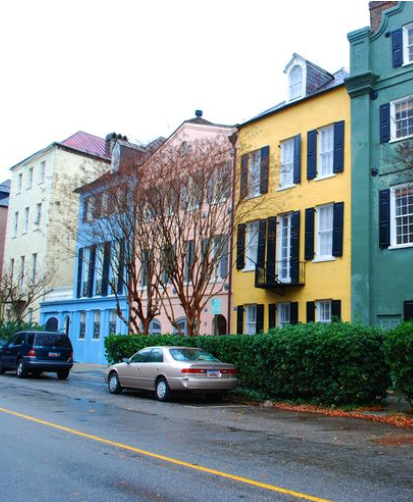RAINBOW ROW
79-107 East Bay Street
Perhaps the most iconic architectural landmark in Charleston, Rainbow Row comprises thirteen 18th and 19th century buildings that once served the bustling wharfs of Charleston’s busy seaport. Running from 79 through 107 East Bay Street, they are now the longest cluster of colonial Georgian Row Houses still standing in America. Most were built shortly after the Great Fire of 1778. The oldest, 97 East Bay Street, was built c. 1748 and thus, through some miracle of wind shift, prayer or chance, pre-dates the fire. The newest, 79/81 East Bay Street, was built in 1845.
The first floors of these buildings originally accommodated stores and counting houses, while the merchants’ family conveniently lived on the upper floors. (No rush-hour commute!) They were originally waterfront property, as the harbor came right up to the other side of East Bay Street. As the wharves running out into the river grew and were filled in, “new” land was created on the eastern side of East Bay Street, and eventually transforming into Concord Street. Thus today, Rainbow Row is a block or so from the water’s edge.
After the Civil War and the catastrophes of the late 19th and early 20th centuries, this neighborhood had devolved into near slum conditions. Then, beginning in the 1920s, this group of row houses became the focal point of the restoration efforts that began when Charleston’s first female real estate broker, Susan Pringle Frost, borrowed money to purchase and renovate several properties in this area. In short order hers became a consuming preservation crusade to rehabilitate the picturesque houses of lower Tradd Street, St. Michael's Alley, and this section of East Bay Street. She would take the proceeds from the sale of first one restored house and invest it in the restoration of the next. Her friend, Dorothy Porcher Legge, purchased 99 and 101 East Bay and undertook their renovation herself.
(Okay, spoiler alert!) The name Rainbow Row is not as historic as you might think. It was coined in the 1930s when the buildings were painted in a variety of pastel shades. Several popular myths have developed over the years to explain their colors. One claims the houses were painted in different colors so that intoxicated sailors coming home drunk at night could remember which houses they were to bunk in. Another version of the myth claims that the colors of the buildings date from their use as stores; purportedly the colors were used so that mistresses could explain to illiterate enslaved people which building to go to when shopping for specific items: for example, sewing goods could be purchased in the blue house.
Neither myth is true as throughout most of their history the buildings were simply a natural stucco gray color and did not feature their pastel paints until the 20th century. The soft-colored palette began with Mrs. Legge, who chose to paint her houses pink based in a Caribbean color scheme for no other reason than that she liked it. Indeed, the palette does recall Charles Town’s close association with the tropical islands of Barbados and the Carribean islands, which seems appropriate given Charles Town's close comnections to those cultures. In addition, the pastel colors help keep the houses a bit cooler inside during the hot summers. After Mrs. Legge restored her property with a pink fascade, other owners followed suit, creating the rainbow of pastel colors that are so popular today.
Today these properties are all private residences and serve as good examples of Charleston’s adaptive reuse of historic buildings. They are perhaps the best known and most photographed site in Charleston today.

